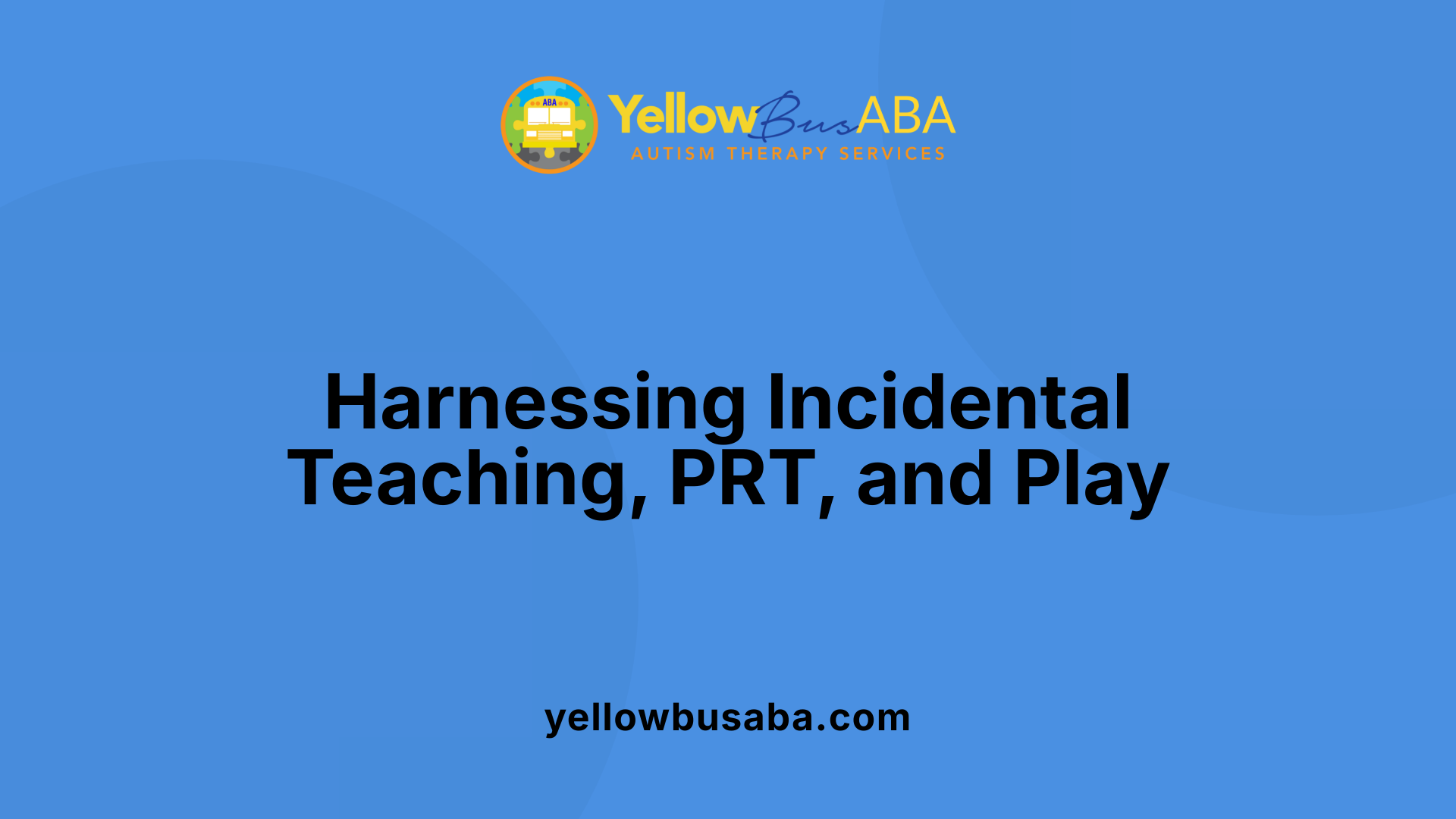Understanding Naturalistic Teaching in ABA Therapy
Applied Behavior Analysis (ABA) therapy has long been a cornerstone treatment for individuals with autism. Recently, naturalistic teaching methods have emerged as a powerful way to make ABA more engaging and effective by embedding learning in real-life contexts. This article explores how naturalistic teaching enhances ABA, the benefits it offers, and its impact on learners, families, and professionals alike.
What is Applied Behavior Analysis (ABA) Therapy?
What is Applied Behavior Analysis (ABA) therapy, and how is it used to support individuals with autism?
Applied Behavior Analysis (ABA) therapy is a scientifically supported approach to understanding and improving behaviors through the analysis of environmental factors. It systematically examines antecedents and consequences to identify why behaviors occur and employs strategies such as positive reinforcement, prompting, and chaining to encourage meaningful skill development.
ABA interventions are individualized, focusing on the unique needs of each person with autism. Therapists design data-driven plans that target key functional behaviors to promote social communication, daily living skills, and decrease harmful or challenging behaviors.
The approach is structured around seven dimensions that guide effective and consistent practice:
- Applied: Interventions focus on socially significant behaviors.
- Behavioral: Emphasis on observable and measurable behavior change.
- Analytic: Demonstrates a clear relationship between intervention and behavior change.
- Technological: Procedures described clearly for replication.
- Conceptually Systematic: Grounded in behavioral principles.
- Effective: Produces meaningful behavior improvement.
- Generality: Skills transfer across people and environments.
This comprehensive framework ensures ABA therapy is evidence-based, systematic, and adaptable across various settings and professionals. By emphasizing functional skill building and behavior modification, ABA therapy empowers individuals with autism to achieve greater independence and meaningful participation in daily life.
Providers and Qualifications in ABA Therapy
Who typically provides ABA therapy, and what kind of training or qualifications do these professionals have?
ABA therapy is delivered by a range of trained professionals, primarily including Board Certified Behavior Analysts (BCBAs) and Registered Behavior Technicians (RBTs). These individuals possess specialized knowledge in behavioral science and interventions focused on autism and other developmental conditions.
Education and Certification Requirements
Most providers hold at least a master's degree in psychology, education, or related fields. Achieving BCBA certification involves completing extensive supervised fieldwork, generally totaling between 1,500 and 2,000 hours. Additionally, candidates must pass a rigorous certification examination and secure licensure where required by regional regulations.
Roles of BCBA and RBT
BCBAs lead the design and supervision of individualized treatment plans. They assess behavioral challenges, select appropriate naturalistic or structured teaching strategies, and monitor therapeutic progress. RBTs, under BCBA supervision, implement these plans by delivering direct one-on-one therapy involving applied behavior analysis techniques.
Supervised Experience and Continuing Education
A critical element of ABA qualification is hands-on supervised practice. This ensures that professionals are competent in real-world application of behavior analysis principles. Continuing education is mandatory, with providers regularly updating their skills and knowledge to adhere to ethical standards and incorporate advances in ABA therapy.
This rigorous training framework helps guarantee that children and families receive high-quality, evidence-based interventions tailored to each individual’s unique needs.
Key Principles of Naturalistic Teaching in ABA
What Are the Core Principles of Naturalistic Teaching in ABA?
Naturalistic teaching in ABA Therapy is built upon several foundational principles that make learning both effective and engaging for children, especially those with autism. At its heart, this method champions child-led learning, meaning the child’s interests and choices guide the educational process. This approach contrasts with more structured methods, encouraging spontaneity and responsiveness.
How Does Learning Occur in Natural Contexts?
Learning happens within everyday routines and familiar settings—play, meal preparation, or trips to the grocery store—rather than in highly controlled environments. This learning in natural contexts ensures that the skills children acquire are meaningful and easily transferable to real life. By embedding lessons within the natural flow of daily activities, children are more likely to stay motivated and engaged.
What Role Do Natural Rewards Play?
Naturalistic teaching emphasizes the use of natural rewards, which are directly linked to the child’s behavior or success. For example, completing a task might lead to playing with a favorite toy or receiving a social interaction, rather than unrelated or artificial rewards. This helps reinforce behaviors in a way that feels relevant to the child, thereby increasing the likelihood of skill retention and generalization.
How Is Functional Skill Building Addressed?
The approach focuses on developing functional skills—abilities that improve independence and social participation. These could include communication, social interaction, or daily living tasks. The teaching is designed to build skills that matter most in a child’s everyday world, making the learning practical and purposeful.
How Does the Approach Foster Learner Motivation?
Motivation is enhanced by centering lessons on the child’s own interests. This method recognizes that children learn best when they are genuinely curious and engaged. By using their preferences as the driving force for teaching, therapists can encourage spontaneous learning and promote sustained attention.
How Are Interests Integrated Into the Learning Process?
Integration of interests means adapting teaching strategies to include activities or subjects the child enjoys. Whether it’s favorite toys, games, or topics, using a child’s preferences creates a natural opportunity for learning. This personal connection makes the experiences meaningful and enjoyable, boosting participation.
Overall, these principles combine the scientific rigor of Applied Behavior Analysis with the dynamic, flexible style of naturalistic teaching. This blend helps children develop lasting skills within environments they encounter daily, preparing them for lifelong success.
Effective Naturalistic Teaching Strategies in ABA Therapy

What are some effective naturalistic teaching strategies?
Naturalistic teaching in ABA therapy harnesses various strategies to promote learning in natural, engaging contexts. These strategies capitalize on everyday situations and the child’s intrinsic interests to foster meaningful skill development.
Incidental Teaching
Incidental teaching involves creating learning opportunities during natural interactions. For example, a therapist might wait for a child to express an interest in a toy before prompting communication or problem-solving skills. This approach encourages spontaneous use of skills as they arise naturally.
Pivotal Response Training (PRT)
PRT focuses on pivotal areas such as motivation, responsiveness, and self-management. It encourages child-directed activities where the learner’s interests determine the flow, helping improve social communication and engagement effectively.
Natural Language Paradigm (NLP)
NLP emphasizes using natural settings to develop language skills. It involves eliciting verbal responses and communication through play or routine interactions rather than scripted drills.
Behavioral Modeling
This strategy uses demonstration of skills by therapists or peers within regular settings. Children observe and imitate to acquire new behaviors naturally.
Play-Based Learning
Play serves as a critical medium where learning is embedded. Through play, children practice social, communication, and cognitive skills while remaining fully engaged and motivated.
Embedding Choices
Offering children options during activities promotes autonomy and decision-making. Embedding choices also increases motivation by catering to individual preferences.
Prompting and Fading
Therapists provide prompts to encourage correct responses, gradually reducing these cues over time to promote independence and generalization of skills.
Together, these naturalistic strategies create a dynamic, enjoyable learning environment. They not only foster functional skills but also prepare children to navigate real-world settings with confidence and adaptability.
How Naturalistic Teaching Enhances Generalization and Engagement

How Does Naturalistic Teaching Support Generalization of Skills?
Naturalistic teaching integrates learning within real-world settings such as homes, playgrounds, and grocery stores. By embedding new skills into everyday activities, children are able to apply what they learn across different environments. This approach promotes flexibility by avoiding rigid structures, which helps prevent skills from remaining isolated to therapy sessions. Instead, children generalize abilities like communication and social interaction to multiple contexts, enhancing overall independence.
How Does Incorporating Interests Boost Engagement?
Naturalistic teaching leverages a child's personal interests to drive motivation. By allowing the child to lead activities based on what they find enjoyable or stimulating, this child-centered method fosters spontaneous, interest-driven learning. Whether it's through play, conversation, or routine tasks, the use of preferred activities increases participation and sustained focus, making therapy both effective and fun.
How Are Real-World Environments Utilized?
Everyday environments provide natural opportunities for teaching meaningful skills. For example, during a grocery store visit, therapists or caregivers can embed communication prompts or decision-making tasks relevant to that setting. This situational learning utilizes natural reinforcement and encourages children to practice skills in familiar contexts, making lessons more functional and memorable.
How Is Motivation Enhanced Through Naturalistic Teaching?
The approach emphasizes natural rewards that relate directly to the task or interest at hand rather than artificial reinforcement. By aligning learning with what the child finds rewarding and meaningful, motivation increases significantly. This intrinsic motivation supports greater engagement and persistence without relying on external incentives.
In What Ways Does Learning Flexibility Increase?
Since naturalistic teaching allows spontaneity and is non-rigid, it adapts to the child's responses and evolving interests. Therapists can adjust prompts and guidance in real-time to suit the moment, encouraging the child to make choices and complete tasks independently. Such flexibility strengthens problem-solving skills and the ability to manage new situations.
How Is Therapy Integrated Into Daily Life?
Parents and caregivers are often trained as co-therapists, making it easier to incorporate teaching into routines like meal preparation or playtime. This family involvement ensures consistent practice and bridges the gap between therapy sessions and daily experiences. The continuous support promotes skill retention and meaningful improvements over time.
| Aspect | Description | Benefit |
|---|---|---|
| Generalization | Learning in natural settings | Skills transfer to multiple contexts |
| Interest-Driven Engagement | Child-led activities based on preferences | Higher motivation and participation |
| Real-World Context | Embedded in daily environments | Functional, meaningful skill use |
| Motivation | Natural, relevant reinforcements | Sustainable, intrinsic desire to learn |
| Flexibility | Adaptive, spontaneous teaching | Enhanced problem-solving and independence |
| Daily Life Integration | Family involvement and routine embedding | Continuous learning beyond therapy |
Benefits of Naturalistic Teaching for Children with Autism

How Does Naturalistic Teaching Improve Communication and Social Skills?
Naturalistic teaching in ABA therapy promotes communication by embedding learning opportunities into a child's natural environment, such as during play or daily routines. This child-led approach encourages spontaneous language use and social interaction, making communication more meaningful and relevant. Techniques like incidental teaching capitalize on natural moments, helping children express needs and engage with others effectively.
What Role Does Naturalistic Teaching Play in Preparing Children for Classroom Settings?
By using real-world contexts, naturalistic teaching prepares children with autism for the structure and social demands of classroom routines. It focuses on practical skill-building through activities that mimic everyday situations, such as group play and following instructions, which fosters adaptability and readiness for school environments.
How Does This Approach Support Long-Term Development and Independence?
Naturalistic teaching emphasizes functional skills and motivation by incorporating the child's interests and natural rewards. This focus enhances skill generalization across settings and promotes independence in day-to-day activities. Engaging learning experiences rooted in real life support sustained development and social competence over time.
In What Ways Does Naturalistic Teaching Provide Individualized Support?
The approach is highly adaptable, tailoring learning to each child's preferences and developmental needs. Therapists and caregivers collaborate to embed teaching moments into activities meaningful to the child, ensuring that instruction is relevant and effective. Family involvement further personalizes support, allowing practice beyond therapy sessions.
Benefits and Potential Limitations of ABA Therapy for Individuals on the Autism Spectrum
ABA therapy, including naturalistic teaching, offers improved communication, social skills development, and reductions in challenging behaviors when individualized and implemented ethically. Yet, it also faces criticism for its repetitive nature and concerns about prioritizing behavior change over emotional well-being. Emphasizing child-led, engaging methods within ABA can mitigate some limitations by fostering motivation and respect for neurodiversity.
The integration of naturalistic teaching with ABA principles results in more engaging, functional, and meaningful learning for children with autism, enhancing their quality of life and long-term success.
Role of Family and Caregivers in Naturalistic ABA Teaching
How do families contribute to naturalistic ABA teaching?
Family involvement is essential in naturalistic ABA therapy. Parents and caregivers act as co-therapists, integrating teaching strategies into daily routines and natural environments like home or community settings. This involvement reinforces learning beyond therapy sessions, helping children practice skills in meaningful contexts.
What is the importance of training parents as co-therapists?
Training parents equips them with knowledge of ABA principles and naturalistic teaching techniques. With adequate training, caregivers can actively support skill acquisition through child-led activities and natural reinforcement. This partnership fosters consistency, improves motivation, and encourages generalization of skills to various settings.
How does integrating naturalistic teaching into daily routines improve child outcomes?
Embedding learning opportunities into everyday tasks such as meals, playtime, or errands increases the relevance and frequency of teaching moments. This integration promotes spontaneous communication, task completion, and social engagement in real-life situations, leading to better retention and independence.
What evidence shows the benefit of caregiver participation?
Studies reveal that when caregivers understand and implement ABA strategies, outcomes improve significantly. Family involvement facilitates meaningful learning experiences, enhances engagement, and supports long-term developmental progress by allowing continued practice outside therapy.
Why is ongoing support and monitoring crucial for families?
Naturalistic teaching requires creativity and adaptability, so therapists provide ongoing guidance to families. Consistent monitoring ensures the approaches remain effective and allows for adjustments based on the child's progress. This collaborative effort sustains therapy gains and encourages sustained skill development.
Challenges and Considerations with Naturalistic Teaching Methods

What are the challenges in implementing naturalistic teaching in ABA therapy?
Naturalistic teaching thrives on creativity and adaptability, as therapists must flexibly integrate learning into spontaneous, real-world settings. This variability can make consistent application difficult since activities depend heavily on the child's immediate interests and natural environment.
Why is maintaining consistency challenging in naturalistic teaching?
Unlike structured methods, naturalistic teaching occurs in less predictable environments, leading to variability in how lessons are delivered. Ensuring consistent reinforcement and progress tracking can be more complex, requiring experienced therapists to balance fluidity with reliable implementation.
What skills do therapists need to effectively deliver naturalistic teaching?
Skilled therapists are essential because they must respond appropriately to unplanned opportunities for instruction, use subtle prompting and fading techniques, and modify strategies based on ongoing observations. This demands a deep understanding of both ABA principles and child behavior in natural contexts.
How does variability in settings affect naturalistic teaching?
Learning environments like homes, playgrounds, or stores differ greatly, influencing the type of instruction possible. Therapists and caregivers must creatively tailor teaching moments to each unique setting while maintaining alignment with therapeutic goals.
Why is monitoring and data collection important in naturalistic teaching?
Because the approach is less structured, ongoing monitoring is vital to track progress and adjust strategies. Involving caregivers in planning and data collection enhances accuracy and helps maintain consistency, ultimately supporting better outcomes.
These considerations emphasize that although naturalistic teaching offers engaging and functional learning opportunities, it requires dedicated professionals and active family participation to overcome inherent challenges and maximize its effectiveness.
Combining ABA with Naturalistic Teaching: A Synergistic Approach

How Do Systematic ABA Principles Support Naturalistic Teaching?
Applied Behavior Analysis (ABA) provides a scientific and evidence-based framework focused on understanding and modifying behavior through reinforcement. This systematic approach ensures that learning is measurable, structured, and data-driven, which supports consistency even within the more flexible naturalistic teaching environment. By integrating ABA principles, naturalistic teaching maintains a focus on clear objectives, ongoing monitoring, and progress tracking.
What Makes Naturalistic Methods Engaging?
Naturalistic teaching emphasizes child-led learning and uses real-world settings such as homes, playgrounds, or grocery stores to create meaningful contexts. These environments make learning immediately relevant and fun by using the child’s interests as motivation. Strategies like pivotal response training and incidental teaching leverage spontaneous interactions, making the learning process more engaging and spontaneous compared to traditional, rigid methods.
How Does This Combination Enhance Motivation and Social Interaction?
Blending ABA with naturalistic techniques enhances motivation by embedding natural reinforcement and learner interests into the teaching process. This child-directed, contextual approach increases the child’s willingness to participate and actively engage in social situations. It also promotes social skills development by using real-life opportunities, helping children generalize learned behaviors across various settings.
What Are the Effectiveness and Measurable Outcomes?
Studies consistently show that naturalistic teaching methods combined with ABA yield positive long-term developmental results. The measurable nature of ABA allows therapists to assess progress reliably, while naturalistic strategies increase the transfer of skills beyond therapy sessions. Family involvement further boosts effectiveness by embedding learning into daily routines and ensuring consistency.
How Is Structure Balanced with Flexibility?
The integration balances ABA’s systematic methods with the flexibility of naturalistic teaching. This requires skilled therapists to adapt to spontaneous situations without losing sight of learning goals. While naturalistic teaching is less predictable, ongoing data collection and parental collaboration ensure that instruction remains purposeful, maximizing the benefits of both structured and child-led approaches.
Real-World Applications: Examples of Naturalistic Teaching in Everyday Settings
Learning in Grocery Stores
Naturalistic teaching often takes place in everyday settings like grocery stores, where therapists or caregivers use real-world tasks to teach skills. For example, during shopping, a child might be encouraged to request items they want or identify colors and numbers, turning routine errands into meaningful learning moments.
Playground Teaching Moments
Playgrounds provide rich environments for social skill development. Children can learn sharing, communication, and turn-taking naturally during play. Therapists may model behaviors or prompt children to engage with peers, embedding learning within fun, spontaneous interactions.
Home-Based Incidental Teaching
At home, incidental teaching occurs during daily activities like mealtime or getting dressed. Caregivers create opportunities for the child to communicate needs or follow instructions naturally, reinforcing skills without rigid structure.
Using Play to Create Communication Opportunities
Play is central in naturalistic teaching to foster communication. By following the child's interests, therapists encourage verbal or nonverbal requests, comments, or social exchanges linked directly to enjoyable activities.
Embedding Choices in Routine Activities
Offering choices during regular routines—such as picking clothes or snacks—empowers children and motivates participation. This strategy enhances decision-making and independence while learning occurs seamlessly within familiar tasks.
These examples illustrate how embedding learning in natural environments and activities helps children with autism gain practical skills that transfer easily to daily life. Such settings increase engagement, make learning more meaningful, and promote generalization across contexts.
Future Directions: Technology and Innovations Supporting Naturalistic ABA
How Does AI Contribute to Progress Reporting in Naturalistic ABA?
Artificial intelligence (AI) is increasingly used to automate the creation of progress reports in naturalistic ABA therapy. By quickly analyzing therapy session data, AI helps therapists track skill development and behavioral changes more efficiently. This automation reduces administrative time, allowing therapists to focus more on direct interaction with children and adapt plans based on real-time information.
In What Ways Does Technology Increase Active Treatment Time?
Technology tools, such as mobile apps and data management systems, streamline documentation and scheduling. This increases the amount of time therapists and caregivers dedicate to active treatment rather than paperwork. Enhanced access to session reminders and digital resources supports consistent implementation of naturalistic teaching strategies, resulting in more productive therapy sessions that better align with a child’s natural environment.
How Does Technology Support Caregiver Training?
Digital platforms offer interactive training modules that help caregivers understand and implement ABA principles within daily routines. Video modeling and step-by-step guides enable parents to become effective co-therapists, ensuring that learning opportunities extend beyond therapy sessions. This increased involvement facilitates skill generalization at home and in community settings.
What Role Does Technology Play in Data Collection and Monitoring?
Advanced data collection tools embedded in AI-driven software can capture detailed behavioral data during naturalistic interactions. These technologies enhance ongoing monitoring, enabling therapists to adjust interventions swiftly to meet individual needs. Automated data visualization further aids in recognizing trends, improving decision-making, and customizing treatment plans.
How Might These Technological Advances Improve Outcomes?
Integrating technology into naturalistic ABA therapy promotes better engagement, motivation, and tracking of progress. Consistent monitoring and caregiver participation supported by digital tools contribute to more meaningful, context-based learning experiences. As a result, children with autism are more likely to develop functional skills that generalize effectively across home, school, and community environments, fostering greater independence and long-term developmental gains.
Naturalistic Teaching: A Vital Component in Modern ABA Therapy
Naturalistic teaching methods have significantly enriched ABA therapy by making learning more meaningful, motivating, and functional for children with autism. By embedding education within real-life contexts and honoring the child’s interests and natural environment, this approach promotes better skill generalization, greater engagement, and enhanced social development. Though it requires skilled professionals and collaboration with families, naturalistic teaching offers a promising path toward greater independence and quality of life for individuals on the autism spectrum. As ABA continues to evolve, integrating naturalistic methods and leveraging technology will be essential to delivering compassionate, effective, and personalized interventions.
References
- Naturalistic Teaching in ABA Therapy for School Readiness
- What Is Naturalistic Teaching ABA?
- What Is ABA Naturalistic Teaching? Understanding Its ...
- ABA and Naturalistic Teaching | Family Priority Blog
- How to Become an ABA Therapist - School of Education
- ABA Clinic Requirements Checklist: What You Need for a ...
- The Controversy Around ABA
- Statement on Use of Applied Behavior Analysis (ABA) for ...
- The 7 Dimensions & Core Principles of ABA
- Applied Behavior Analysis (ABA)






